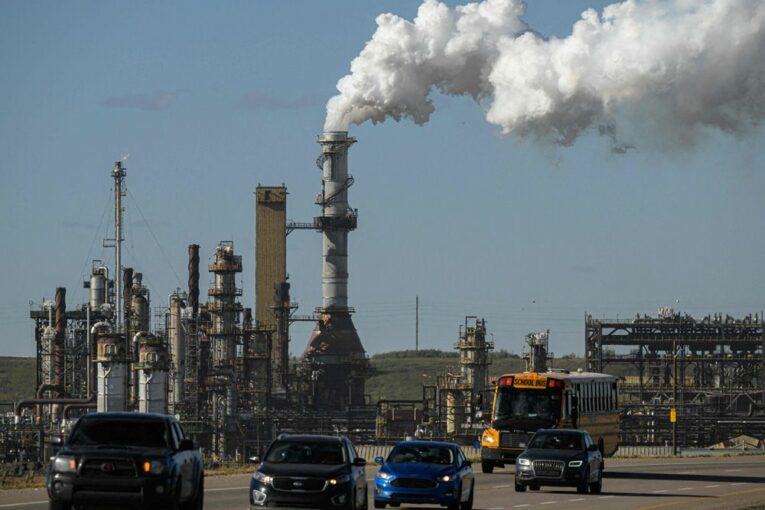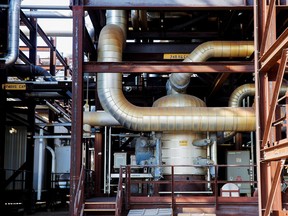
By the end of 2023, the majority of the policy required for Canada to meet its 2030 emissions goals will be in place, representing a watershed moment for the country’s climate response — and a reckoning for the oilpatch.
Canada has promised to reduce greenhouse gasses by 40 per cent below 2005 levels by 2030, and the year ahead will bring a suite of climate policies that will disrupt the energy industry. Key among them are: the establishment of a cap on emissions from the oil and gas sector and new measures to firm up carbon pricing, including carbon contracts for differences, which would provide companies and investors clarity by locking in prices.
And while not aimed directly at emissions reduction, Ottawa’s long-promised and controversial “Just Transition” legislation also could drop early this year. Prime Minister Justin Trudeau promised programs that would ease the exit of thousands of oil and gas workers from an industry destined to shrink — a proposal vociferously opposed by Alberta Premier Danielle Smith, who has decried the policy as “extremely harmful” to Canadians whose livelihoods depend on the energy industry.
But executives in the Canadian oilsands, one of the most carbon-intensive sources of crude in the world, are acutely aware the industry’s long-term prospects depend on taking climate change seriously. They are laser-focused on pushing provincial and federal governments to write climate policies that won’t threaten continued oil and gas production, while banking on government support for large-scale decarbonization infrastructure projects, such as carbon capture and storage.
“It is a pivotal year. 2023 will determine whether we achieve these 2030 targets,” said Kendall Dilling, head of the Pathways Alliance, a consortium of six oilsands majors, including Canadian Natural Resources Ltd., Cenovus Energy Inc., ConocoPhillips Canada, Imperial Oil Ltd., MEG Energy Corp. and Suncor Energy Inc.
“We’re not doing this because we’re being regulated to do it. We’re doing this because our CEOs truly have a conviction that we don’t have a long term future if we can’t address what’s been our Achilles heel: our greenhouse gas emissions.”
According to the Canadian Climate Institute, three of the five government policies required to meet Canada’s 2030 emissions targets could be finalized this year. One of the most consequential will be the cap on oil and gas sector emissions, a measure that could account for a 33-megatonne reduction by 2030, or approximately 18 per cent of the reduction required to meet the target.
“They need to now put their money where their mouth is and we need to see some shovels in the ground on some of these projects,” said Rick Smith, the institute’s president. “I absolutely think that Canadian industry gets the necessity of this now as a competitive reality,” he added. “This notion of a transition being upon us is not controversial and and the oil and gas industry itself is planning with this eventuality in mind.”

While some see the cap as an existential threat to the industry, economists who have analyzed federal climate plans say there is a scenario where the Canadian oil and gas sector could remain profitable while achieving deep reductions in emissions. This would require a combination of methane regulations, carbon pricing and carbon capture and storage working in concert to allow the sector to generate surplus tradable emissions credits that could be sold to other large emitters.
But maintaining profitability under a strict emissions cap would require companies to make significant investments in compliance or decarbonization projects such as the Pathways’ proposed $16.5-billion carbon capture and storage network in northern Alberta, a project that oilpatch leaders have argued is essential in order to decarbonize.
They also have said that scaling up carbon capture will require more federal incentives on par with the tax credits and grants on offer in the United States and elsewhere.
“We will continue to invest heavily, but in order to truly attract the capital that’s going to be required to do this… we will have to be competitive with those other jurisdictions,” Dilling said.
Canadian energy companies have joined many economists in calling for a firming up of carbon pricing to safeguard investments in decarbonization, including carbon contracts for differences, which guarantee a minimum future price by ensuring that businesses that invest in emission-slashing projects will be compensated if carbon prices are eliminated or fall below an agreed strike price.
Such a measure could finally materialize in 2023, according to public statements by Natural Resources Minister Jonathan Wilkinson and Deputy Prime Minister Chrystia Freeland.
Dilling said the industry is largely agnostic on the exact mix of policies, but that governments must be willing to do more to alleviate the cost burden of decarbonization. He said carbon contracts for differences, a carbon capture production tax credit or breaks on provincial royalties could play a role.
“That’s the work of 2023: to figure out exactly what is the most efficient instrument from a regulatory deployment, taxation perspective and everything else,” said Dilling, adding that the sector will continue to invest heavily in reducing emissions.
“We know it’s the right thing to do. We know it’s what’s necessary for our long term sustainability. It’s also our financial institutions, our insurers, our shareholders and a host of other stakeholders who are saying that they want to see us recreate ourselves and be relevant in a low-carbon future.”
• Email: [email protected] | Twitter: mpotkins
You can read more of the news on source
